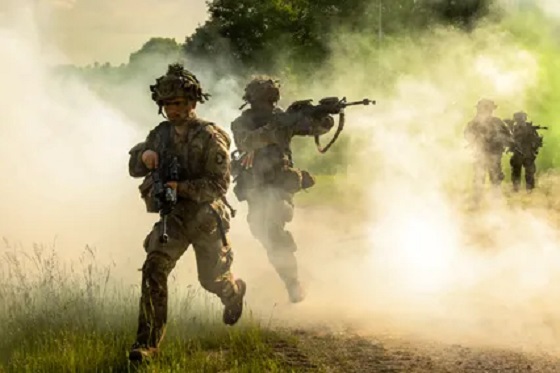armed forces
NATO spending pledge—federal government faces lose-lose situation

From the Fraser Institute
By Grady Munro and Jake Fuss
for Canada to meet the target and maintain it through 2026/27, it must increase defence spending by $57.1 billion
During his recent visit to Poland, when asked about Canada’s responsibility to NATO, Prime Minister Trudeau acknowledged that “there is still more to do.” Indeed, at the Vilnius Summit last summer, the 31 member countries of NATO, which includes Canada, once again pledged to spend a minimum of 2 per cent of their gross domestic product (GDP) on defence. Unfortunately, with no plan to reach this benchmark, the Trudeau government is in a lose-lose situation—accumulate billions more in debt or further disappoint its allies.
According to NATO, the 2 per cent minimum pledge will ensure the alliance’s military readiness and improve the credibility of the organization.
Yet Canada (a founding member of NATO) has failed to reach this target every year since first making this pledge in 2006. In 2022, the latest year of available spending data, Canada’s defence spending measured 1.29 per cent of GDP—fifth-lowest in NATO and well short of the 2 per cent target. And much of Canada’s recent progress towards the spending target is due to a 2017 change in NATO’s definition of “defence spending.” Consequently, Canada has been branded a “military free-rider.”
Although most NATO countries haven’t reached the spending benchmark either, this is changing as the war in Ukraine continues. Seven members spent more than 2 per cent of GDP in 2022, and it’s estimated that 11 members will meet the target in 2023. With more members fulfilling their pledge, Canada likely will fall further behind it allies without higher defence spending. Yet according to the Parliamentary Budget Officer, for Canada to meet the target and maintain it through 2026/27, it must increase defence spending by $57.1 billion.
Unfortunately, due to the Trudeau government’s record-high spending, Ottawa is in a weak fiscal position. From 2014/15 to 2023/24, the federal government increased per-person program spending from $9,064 to $11,395 (adjusted for inflation), primarily by borrowing. As a result, the government has racked up substantial debt and projects more borrowing in the coming years, with no balanced budget in sight.
Without a plan to restrain spending in other areas to accommodate a $57.1 billion increase in defence spending, the government would have to rely on debt to meet the 2 per cent target. This would significantly increase future deficits. In 2023/24 alone, the deficit would increase from $40.0 billion to $55.5 billion. The next several years would also see deficits increase by no less than $13.0 billion. In total, from 2023/24 to 2026/27, cumulative budget deficits would increase from $143.8 billion to $200.9 billion. Such an increase would substantially weaken an already shaky fiscal position.
Despite this, it’s unlikely the Trudeau government would rework its spending to avoid such debt accumulation. Since 2014/15, the majority of spending increases have gone towards expanding or implementing new programs such as the Canada Child Benefit or $10-a-day daycare, rather than core government functions such as defence or justice.
In fact, the government increasingly treats defence as an area to find additional savings. It recently cut the defence budget by $210 million, and it’s rumoured additional cuts of $1 billion are on the way. Clearly, spending on new programs takes precedent for this government, leaving Canada in arrears on its NATO commitment.
If the Trudeau government intends to uphold its recent defence spending pledge, but is unwilling to change its priorities, then Canadians will likely see Ottawa’s mountain of government debt grow even higher. But should the government again fall short of the NATO target, Canada’s reputation among its allies will continue to deteriorate.
Authors:
armed forces
Trump rebuilds the ranks: Army crushes 2025 recruitment goal early

 MxM News
MxM News
Quick Hit:
The Army has already exceeded its 2025 recruiting goal of 61,000 troops—four months ahead of schedule—as the Trump administration’s rollback of woke policies draws thousands back to military service.
Key Details:
-
The Army’s 2025 recruiting goal was 61,000—higher than last year’s 55,000—and has already been met with more than four months remaining in the fiscal year. Officials report a 56% increase in average daily enlistment rates over last year.
-
Army Secretary Daniel Driscoll thanked Trump and Hegseth, saying their “decisive leadership” and “putting soldiers first” contributed to the record-breaking numbers.
-
Hegseth has aggressively pushed to eliminate leftist cultural initiatives in the military, including moves to administratively separate transgender troops and rename a Navy ship previously dedicated to gay rights icon Harvey Milk.
Diving Deeper:
The U.S. Army has reached a major milestone ahead of schedule—signing up 61,000 new recruits in fiscal year 2025, effectively smashing its annual goal months before the September 30th deadline. The achievement marks a dramatic shift after years of underperformance and is being touted as a vindication of the Trump administration’s efforts to reorient the military away from progressive social engineering and back toward warfighting readiness.
In a Wall Street Journal op-ed Tuesday, Army Secretary Daniel Driscoll praised the recruiting corps, attributing their success to both boots-on-the-ground determination and high-level support. “I’m incredibly proud of our U.S. Army recruiters and drill sergeants,” he said. “Their colossal efforts and dedication to duty helped the U.S. Army accomplish our FY25 annual recruiting goal a full four months ahead of schedule.” Driscoll continued, “I want to thank the commander in chief, President Trump, and Secretary of Defense Hegseth for their decisive leadership and support.”
The Army’s target of 61,000 recruits was a notable jump from last year’s 55,000 goal. Officials say that as of this month, daily enlistment figures are tracking 56% higher than the previous year.
Driving the increase, many believe, is the sweeping overhaul of military culture underway under Defense Secretary Pete Hegseth. Hegseth has made no secret of his intent to steer the armed forces away from what he calls “woke and weak” policies. That includes the Pentagon’s past focus on gender identity politics, climate initiatives, and mandatory diversity training—priorities Hegseth sees as incompatible with combat readiness.
“We are leaving wokeness and weakness behind,” Hegseth declared during remarks last month at the Special Operations Forces Week convention in Tampa. “No more pronouns, no more climate change obsession, no more emergency vaccine mandates. No more dudes in dresses. We’re done with that s***.”
Hegseth emphasized a military rooted in “lethality, meritocracy, accountability, standards and readiness,” and added pointedly, “Our combat formations don’t need to look like Harvard University—they need to look like killers.”
In line with that shift, Hegseth also this week ordered the Navy to remove Harvey Milk’s name from a replenishment ship. The vessel had been named in honor of Milk, a gay rights activist and former Navy officer who was elected to the San Francisco Board of Supervisors in 1977 before being assassinated a year later.
The directive aligns with what Hegseth calls “warrior culture” and the broader mission to reflect Trump administration priorities across the military’s assets and institutions. The Pentagon has yet to confirm a new name for the USNS Harvey Milk, and a spokesperson said reviews are ongoing.
The Army is set to mark its 250th anniversary on June 14th—a symbolic moment, officials say, as it reclaims its footing and begins to rebuild the force from a position of strength.
armed forces
New Trump-Pentagon ad resets mission: end wokeness, win wars

Quick Hit:
The Pentagon released a dramatic new ad Sunday featuring President Trump and Defense Secretary Pete Hegseth, highlighting the end of woke policies in the military and a renewed focus on strength, discipline, and warfighting.
Key Details:
-
The ad, titled Peace through Strength, features intense training and combat scenes, underscored by speeches from Trump and Hegseth.
-
“No more distraction, no more electric tanks, no more gender confusion, no more climate change worship,” Hegseth proclaims, signaling a sharp pivot from recent Pentagon policies.
-
Trump promises that under his leadership, U.S. military success will be defined “not only by the battles we win, but also by the wars we end,” calling for peace built on American strength.
NEW U.S. MILITARY AD HITS HARD🇺🇸
"We are laser focused on our mission of warfighting… Our friends will respect us, our enemies will fear us, and the whole world will admire the unrivaled greatness of the United States Military" pic.twitter.com/jdm3MikswO
— The White House (@WhiteHouse) May 27, 2025
Diving Deeper:
The Pentagon launched a forceful new recruitment and branding campaign over Memorial Day weekend, spotlighting the military’s return to fundamentals under the leadership of Defense Secretary Pete Hegseth and President Donald Trump. The minute-long ad, titled Peace through Strength, premiered Sunday at the Coca-Cola 600 NASCAR event and was simultaneously posted to the Department of Defense’s social media accounts.
Using fast-paced training footage and dramatic music, the ad showcases troops in battlefield simulations and highlights a no-nonsense message from the Trump administration. Hegseth opens with a clear declaration: “No more distraction, no more electric tanks, no more gender confusion, no more climate change worship. We are laser-focused on our mission of warfighting.”
The video includes remarks from Trump affirming his vision for a military built on discipline and deterrence. “Through our power and might, we will lead the world to peace,” he says. “Our friends will respect us. Our enemies will fear us. And the whole world will admire the unrivaled greatness of the United States military.”
The ad was produced using previously recorded training footage, according to a Pentagon spokesperson who spoke to The New York Post.
Hegseth also makes a direct appeal to America’s youth, praising “incredible” young men and women “giving up the best years of their lives” to defend the country. He closes the ad with a quote that underscores the values behind the mission: “We don’t fight because we hate what’s in front of us. We fight because we love what’s behind us.”
The backdrop to the ad is a recruiting crisis that had plagued the military under Biden. In fiscal year 2022, the U.S. Army fell short by roughly 25% of its enlistment target. Similar gaps were recorded across other branches in 2023, with both the Navy and Air Force reporting thousands fewer recruits than needed.
Reversing that trend has been a key objective for Hegseth. He has made it clear that returning to a warrior culture—and scrapping the distractions of social experimentation—is central to solving the problem.
The ad’s release comes just days after the House passed the One Big Beautiful Bill Act, which adds $150 billion in new military funding. That package includes investments in shipbuilding, defense modernization, and Trump’s space-based Golden Dome missile defense initiative.
Together, the new ad and the legislation serve as a one-two punch from the Trump administration, signaling a full-spectrum push to rebuild, rearm, and reinspire the U.S. Armed Forces.
-

 Crime8 hours ago
Crime8 hours agoHow Chinese State-Linked Networks Replaced the Medellín Model with Global Logistics and Political Protection
-

 Addictions9 hours ago
Addictions9 hours agoNew RCMP program steering opioid addicted towards treatment and recovery
-

 Aristotle Foundation10 hours ago
Aristotle Foundation10 hours agoWe need an immigration policy that will serve all Canadians
-

 Business7 hours ago
Business7 hours agoNatural gas pipeline ownership spreads across 36 First Nations in B.C.
-

 Courageous Discourse5 hours ago
Courageous Discourse5 hours agoHealthcare Blockbuster – RFK Jr removes all 17 members of CDC Vaccine Advisory Panel!
-

 Health1 hour ago
Health1 hour agoRFK Jr. purges CDC vaccine panel, citing decades of ‘skewed science’
-

 Censorship Industrial Complex4 hours ago
Censorship Industrial Complex4 hours agoAlberta senator wants to revive lapsed Trudeau internet censorship bill
-

 Crime11 hours ago
Crime11 hours agoLetter Shows Biden Administration Privately Warned B.C. on Fentanyl Threat Years Before Patel’s Public Bombshells




